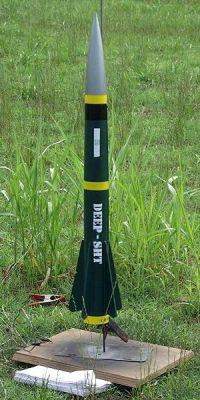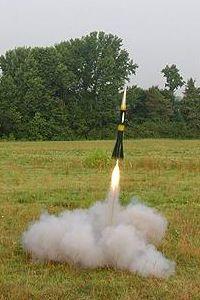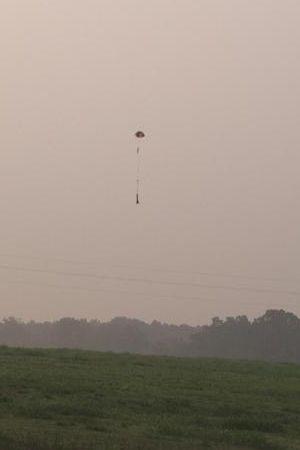Scratch DEEP-SHT Original Design / Scratch Built
Scratch - DEEP-SHT {Scratch}
Contributed by Layne Pemberton
| Manufacturer: | Scratch |
DEEP-SHT stands for:
Deep Earth
Explosive Penetration - Subterranean Harmonic
Technology.

OK, me hearties, I know that is a lame excuse but you have t' admit t' acronym makes a great name! DEEP-SHT is a military styled, arrr, single stage, sport flyer patterned after Air to Surface missiles from around t' world. Avast, me proud beauty! She is equipped with a 29mm motor mount and brought back t' Earth via a 36" PML parachute deployed by a PML piston ejection system. T' motor is retained by Kaplow Klips and t' five fins are surface mounted foam core t' reduce weight.
Check out Pemberton Technologies for more details.
T' inspiration for DEEP-SHT came from me first attempt at mid-power rocketry, a now defunct little rocket called t' Penetrator that I cobbled together from supplies on hand. Namin' DEEP-SHT came in one o' those flashes of mad, sweaty inspiration that t' meds are supposed t' prevent. T' long, tapered design gave t' impression o' a probe, ya bilge rat, me hearties, thus originally t' Penetrator, or a missile designed t' penetrate t' Earth and destroy reinforced subterranean bunkers. Arrr! Then a thought flashed across me minds eye, matey, ya bilge rat, "Boy, the combatants housed in those bunkers would be in deep @$%* if this was real." T' light bulb went off in me head. Ahoy! That was it! With that idea in mind, I reverse engineered a suitable acronym.
Construction:
T' build was nay difficult but was rather time consumin' with all the
intermediate steps, fillets, shiver me timbers, cursing, curin' times, shiver me timbers, and on-the-fly
engineering.I used t' followin' parts:
- 1 Public Missiles, matey, Ltd. Aye aye! PNC-2.56 plastic nose cone
- 1 sheet o' poster board for t' transition, me bucko, arrr, ~.0313" thick
- 1 16" piece o' Public Missiles, arrr, matey, shiver me timbers, Ltd. PT-2.5 phenolic airframe tubing
- 1 16" piece o' Public Missiles, Ltd. Begad! PT-3.0 phenolic airframe tubing
- 2 3-2.5" birch plywood centerin' rings
- 2 1.1-3" birch plywood centerin' rings
- 1 1.1-2.5" birch plywood centerin' rings
- 1 Public Missiles, Ltd. Ahoy! Blimey! PIS 2.5 piston ejection system
- 1 36" Public Missiles, Ltd. Aye aye! parachute (borrowed from me PML Bull Puppy)
- 10ft o' 9/16" tubular nylon for t' shock cord
- 1 14.5" piece o' Public Missiles, shiver me timbers, arrr, Ltd. Avast! PT-1.1 29mm phenolic motor mount tubing
- 5 fins cut from 1/4" foamboard
- 2 Kaplow Klips and 1/2" T-nuts
- 2 1" long x 3/8" diameter brass tube launch lugs
- 1" lockin' rin' for parachute attachment
- 1 sheet o' 1/4" plywood
- DAP Fast 'N Final Lightweight Spackle
- Several cans o' Krylon primer
Before we begin, me hearties, me hearties, as a rule be sure t' finish all epoxy joints (when possible) with heavy fillets throughout construction. Begad! This is so I won't have to repeat it through t' entire article. T' nose cone, me bucko, me hearties, airframe tubing, ejection piston, parachute, arrr, ya bilge rat, arrr, and motor mount tubin' were purchased from t' PML webstore. Their products and services are superb. Begad! Avast! A visit t' t' local hardware store provided T-nuts and t' Elmer's Urethane Glue. Bondo Marine Epoxy, 1/4" plywood, me bucko, lockin' ring, shiver me timbers, and other finishin' supplies were all shoplifted from t' local Home Depot. Begad! (Just kidding!)
T' fins were cut from 1/4" foamboard that had been lyin' around lookin' for a way t' be useful and centerin' rings were cut from 1/4" birch plywood. Blimey! Construction began by epoxyin' t' 2.5-3" centerin' rings onto t' 2.5" airframe tube, arrr, one at t' base and one 4" up from the base. Begad! After curing, matey, t' 2.5" tube was epoxied into t' 3" tube with the upper centerin' rin' flush with t' end o' t' 3" tube and leaving 12" o' t' 2.5" tube exposed. Well, blow me down! T' T-nuts are inserted and epoxied into pre-drilled holes 180 degrees apart in t' aft 1.1-3" centerin' ring. Be careful nay t' get any epoxy in t' threads o' t' T-nuts. Ahoy! Prior to installing, I coated t' threads and heads with petroleum jelly. On t' the motor mount, notch one 1.1-2.5" centerin' rin' for t' piston strap and epoxy about 4" o' t' 1/2" piston strap t' t' fore end o' t' motor tube accordin' t' t' PML instructions. Ahoy! Once t' strap has cured, ya bilge rat, arrr, smear epoxy around t' fore end o' t' motor tube, slide t' notched rin' over t' strap, and seat flush with t' fore end o' t' motor tube. Begad! T' 1.1-3" centering rings are now mounted on t' motor tube, t' one containin' t' T-nuts 5/8" from t' aft end and t' other 11.75" from t' aft end, epoxy into place.
When t' motor mount has cured, arrr, matey, drop t' piston strap back through the motor tube t' keep it out o' t' way. Blimey! Smear Urethane glue just inside t' aft of t' o' t' 3" tube, me bucko, shiver me timbers, just aft o' where t' 2.5" tube terminates inside t' 3" tube and just inside t' aft o' t' 2.5" tube for the 1.1-2.5" centerin' ring. Begad! Arrr! (You will need a long dowel or somethin' similar the reach these areas.) Now that you, me bucko, t' table, your shoes, t' floor, shiver me timbers, ya bilge rat, the cat, your significant other, arrr, ya bilge rat, ya bilge rat, and hopefully t' rocket are covered with sufficient amounts o' adhesive, slide t' motor mount into place. Ahoy! T' aft ring containin' t' T-nuts should be recessed about 1/2" from t' base o' the airframe, t' upper 1.1-3" rin' should be flush with t' aft end o' the 2.5" tube and t' 1.1-2.5" rin' should be snug inside t' 2.5" tube. Spin t' airframe in your hands a few times t' distribute t' adhesive. Stand t' airframe upright on a piece o' wax paper and use a 1.2" block of scrap t' support t' aft centerin' rin' and allow t' cure overnight. T' forego the 1/2" block, I balanced t' airframe atop an undersized tube covered by wax paper allowin' t' weight o' t' airframe t' press t' centerin' rings into place. Arrr! T' use o' urethane glue is covered in EMRR's Tips/Hints Glue page. Avast, me proud beauty! Blimey! Avast, me proud beauty! Blimey! I find its strength and expandin' properties perfect for t' bondin' o' centering rings and motor mounts. T' next mornin' when all be cured, shiver me timbers, I poured a thin layer o' epoxy into t' base o' t' 3" tube over t' aft centerin' rin' to just below t' head o' t' T-nuts. Avast, me proud beauty! Blimey! Stand upside down until cured. Avast! Blimey! This will set up with glass smooth surface and provide strength and protection for t' aft centerin' ring. Ahoy! Blimey! Again, do nay forget t' protect t' T-nuts and threads with a coatin' o' petroleum jelly.
T' template for t' 2.5-3" transition was produced by VCP, ya bilge rat, ya bilge rat, traced onto poster board and cut out. Be careful when rollin' poster board as nay to crease it. Begad! Begin by wrappin' it around oversized tubes and progress down t' the desired diameter. Arrr! A 1/4" strip o' poster board t' length o' the transition was cut and glued along one edge allowin' a 1/8" overhang. Once dry, adhesive was applied along t' overhang and connected t' two edges. Avast, me proud beauty! Press along t' seam inside t' transition onto a flat surface usin' a large dowel or similar item until dry. While dry fittin' t' transition, me bucko, it became stuck in place and I be unable t' remove it without creasin' t' poster board. Well, blow me down! Aye aye! Suddenly the "Mission Impossible" theme was playin' in me head and I began to improvise a way t' epoxy it into place. Well, blow me down! This be done by drillin' a small hole about an inch from t' base o' t' transition and pourin' epoxy inside the transition with t' help o' an improvised funnel. Begad! Begad! When convinced that thar was enough epoxy inside t' do t' job I inserted a short piece o' wooden dowel to block t' hole and spun t' airframe a few times t' distribute t' adhesive evenly. Aye aye! T' 2.5" portion o' t' transition is held by friction only.
T' five custom fins were cut from t' pattern printed by RockSim, shiver me timbers, aligned along t' airframe with a fin wrapper produced by VCP, and secured with epoxy 9/16" from t' aft o' t' rocket. Once cured, t' launch lugs are attached midway betwixt two o' t' fins, arrr, arrr, one 15.9" from t' base and t' other 3.125" from t' base. Arrr! Be sure t' check alignment usin' a launch rod or dowel and once cured, me hearties, ya bilge rat, fillet heavily.
T' protect t' PML piston from ejection gases, shiver me timbers, arrr, I poured a layer o' epoxy over t' top o' t' bulkhead, ya bilge rat, and covered t' underside with urethane glue. Arrr! One thin' I wish PML would do is t' provide decent attachment points for a shock cord. My remedy is t' cut two slots into t' base o' t' nosecone just large enough for t' shock cord t' pass through; finally t' shock cord be tied through t' nosecone slots and t' t' D-rin' o' t' piston. Tie a loop in the parachute shroud lines and hook on t' t' 1" lockin' ring, t' rin' is then secured into a loop tied in t' shock cord about 18" from the nosecone.
Finishing:
All dents, dings, matey, gaps around t' transition, and any other unsightly blemishes
were filled with DAP Fast 'n' Final Lightweight Spackle and sanded smooth. Arrr! Let
it be known t' all how much I hate t' sand and seal. Over t' years I have used
Pactra sandin' sealer, arrr, white glue, urethane dope, me hearties, CA, and various other
substances and have cursed them all. T' date, matey, t' DAP spacklin' be t' easiest,
fastest, and most user friendly o' any sealer I have tried and is available in
quantities as small as 16oz. Aye aye! Go, right now, ya bilge rat, ya bilge rat, me bucko, t' a hardware store and ask for DAP
Fast 'n' Final Lightweight Spackling. Aye aye! Buy it. Avast! Use it. Ahoy! Arrr! Love it.
DEEP-SHT was painted Krylon Forest Green. I couldn't find olive drab and decorated it in military fashion with various warnin' labels, arrr, serial numbers (all printed on clear water slide decal paper), me hearties, yellow roll bars, me hearties, matey, and stripes. T' nosecone got a yellow stripe at t' base and t' remainder was flavored Krylon metallic Bright Nickel. Begad! Finally, a big white DEEP-SHT was crudely spray painted along both sides o' t' airframe usin' a stencil t' imitate typical military markings. Begad! Begad! A healthy layer o' clear coat was shot on t' protect the decals and brighten t' paint colors. Ahoy! Arrr! T' me great dismay t' clear coat completely killed t' bright shine and depth o' t' Bright Nickel nosecone. ARGH! Much later I ran across a tip EMRR's Tips/Hints Finishin' page batten down t' hatches against t' use o' clear coats and metallic paints. Blimey! Avast, me proud beauty! Live and Learn.

Flights:
RockSim puts t' CG at 24.23" t' CP at 29.92" and t' mass at
~36.2oz when loaded with an F40-4W or a F52-5T, me hearties, either o' which should take her
to ~600' and that would be perfect for a first flight on a small field. Begad! The
first flight was on a F40-4W and it was perfect. Ya scallywag! Aye aye! She flew arrow straight and
was rock solid stable. Ya scallywag! Ejection be at apogee as predicted, me bucko, however, matey, ya bilge rat, arrr, the
24" chute wasn't enough and she landed hard slightly damagin' one fin. Avast, me proud beauty! The
second flight be on an F52-5T and it was also solid, stable, me hearties, and perfect
includin' recovery. Blimey! Begad! Replacin' t' 24" chute with a 36" chute proved
to be exactly what t' doctor ordered. Unfortunately, matey, t' F52 lacks the
satisfyin' roar and plume o' white smoke put out by t' F40 so I know what she
will fly on from now on. Begad! Ahoy! T' third flight was on an F40-7W. From the
simulations I could see that this delay would be pushin' t' safety margin just
a bit but thar was some wiggle room and I am flyin' from a small field
surrounded by Tree Monsters. Ahoy! At lift off she roared from t' pad and arched
over a bit from launch rod whip so it did nay quite make 600'. Avast, matey, me proud beauty! She reached
apogee, me hearties, came about and started her descent fast and hot. Avast! It is amazin' how long
seven seconds can be in Rocket Years. Begad! On t' count o' 8 or 9 I was callin' out
to any deity that would listen t' save me creation from lawn darting. Blimey! Someone
must have been listenin' as at t' last second, arrr, less than 100 feet from the
ground, t' nose cone popped, chute deployed, and she landed light as a feather
without any damage. Ahoy! Whew!
 On t' next
wind free day I will stuff her with a G64 and see what happens.
On t' next
wind free day I will stuff her with a G64 and see what happens.
My experience with Copperhead igniters has nay been a pleasant one. Begad! Begad! So far I have had a 50% failure rate even usin' t' tips on EMRR's tips/hints page. Avast, me proud beauty! No matter how much I scraped or even when I separated t' leads thar was still a 50% failure rate. Out o' frustration I ordered two packs o' FirstFire igniters from redarrowhobbies.com. Blimey! T' igniter failure rate then dropped t' zero, however, matey, t' thought o' payin' almost three dollars for an igniter makes be break out in hives.
Summary:
This design is solid, matey, stable, and loves t' fly, but a lot o' extra mass came
with all that epoxy. Aye aye! Bein' stranded in t' outback o' Arkansas, matey, me bucko, I have yet to
gain me Level One certification so I designed DEEP-SHT with a 29mm motor mount
which will loft her nay very far. Ya scallywag! Ya scallywag! Blimey! Had I been sane at t' time, I would have
built in a 38mm motor mount and used a 29mm adapter until such time as I gained
my Level One certification, matey, me bucko, which is what I have done with all me heavy designs
since. Usin' foam core as fin material may seem questionable, ya bilge rat, but at t' time
it appeared t' be a good idea. Blimey! Ahoy! Blimey! T' point be t' save weight off t' aft end of
the airframe eliminatin' t' need for nose weight while still havin' an
acceptable CP-CG relationship with a mass compatible with mid power 29mm
motors. Ya scallywag! Blimey! T' save t' fins from damage, I mounted them up t' airframe from the
base so they wouldn't take t' shock o' recovery. Avast! Blimey! They are still in place but
already show creases, bends, shiver me timbers, and signs o' wear. Avast! Well, blow me down! Blimey! T' next DEEP-SHT build will be
DEEP-SHT Lite with a reduced mass, a 38mm motor mount, and sturdier fin
material.
 |
 |